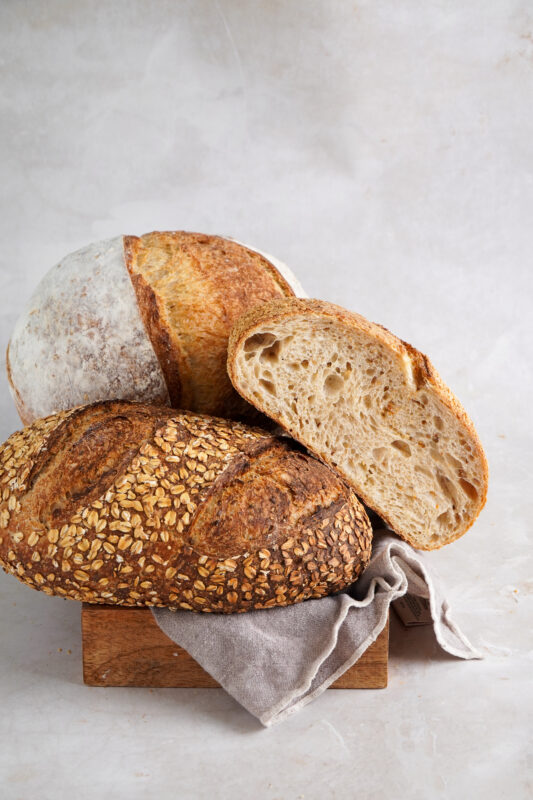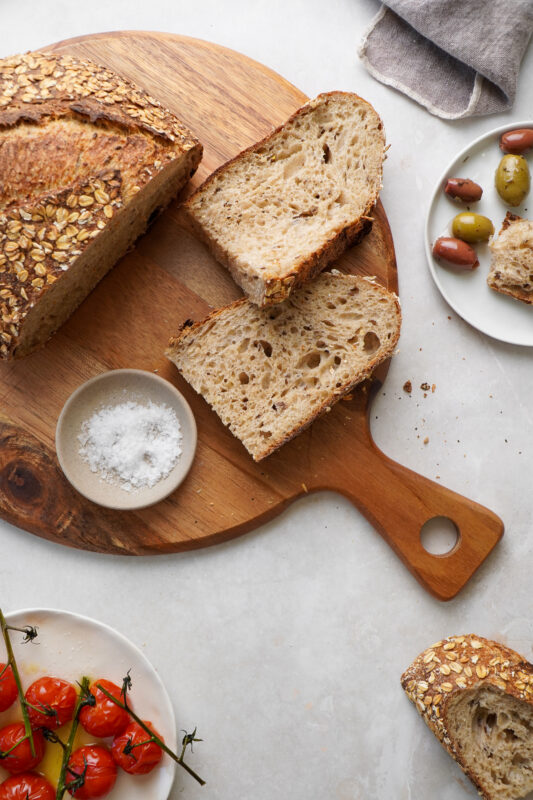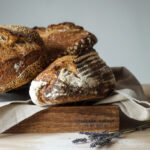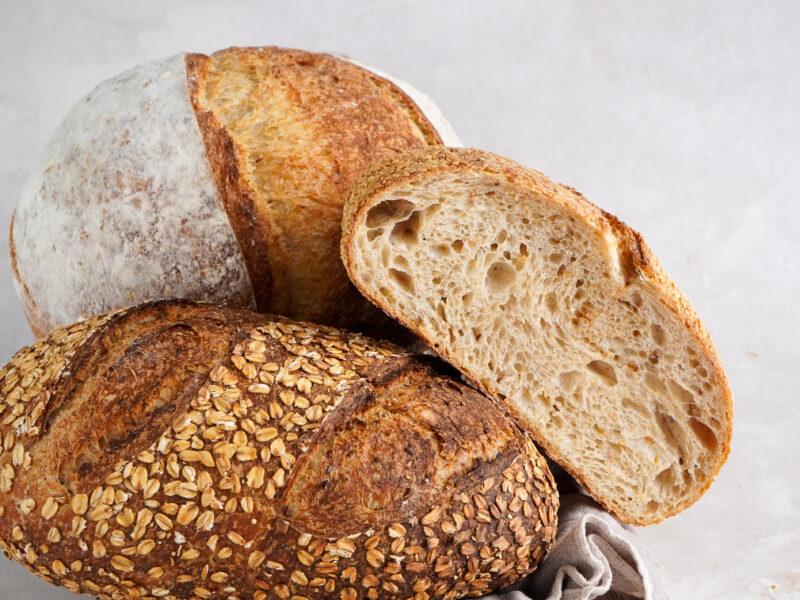If you want to learn how to bake delicious multigrain spelt bread, then this is the recipe for you. These tips will give you perfect bread, every single time.

One of my favorite things about this multigrain spelt bread is that you get a mix of grains and nutrients. Since it uses white bread flour, spelt flour, and the soaked combination of quinoa, flax, and other grains, you’ll enjoy more minerals and different nutrients than if you baked with just one type of flour.
But the health aspects aren’t the only thing my family loves about this bread. My husband makes some incredible sandwiches, and since this bread isn’t as fluffy as the basic sourdough recipe, it holds up better to whatever filling and spreads he uses.
Plus, the combination of grains in the bread gives it a unique nutty flavor that pulls my kids to it.
There is something that everyone loves about this spelt multigrain recipe.
What Is Spelt Flour?
Spelt flour comes from the ancient grain spelt. What is spelt? In the 19th century, people stopped using spelt to make bread because modern wheat varieties were more popular.
There has been a recent resurgence in spelt’s popularity after more and more people heard about how nutritious it is and how delicious it tastes.
Is it really healthier? Spelt has a tough outer husk that protects the nutrients inside the grain, so it has more nutrients that other types of grain. It’s a fantastic source of dietary fiber, protein, and essential minerals like manganese, magnesium, phosphorus, and zinc.
Spelt flour comes in two forms – white and whole spelt.
To learn more about white spelt flour, read my white spelt flour recipe.
This recipe uses whole-grain spelt flour, and there are some important things you’ll do differently when you bake with it instead of white spelt flour.

Baking Tips
When you bake with whole grain spelt, there are a few things you’ll have to do differently when compared to basic sourdough or white spelt bread.
High Hydration: The Secret To Light Whole Grain Bread
Whole grain spelt absorbs a lot of water. The trick to a light whole grain bread is high hydration and soaking your whole grains 4-6 hours before using it, so the grains don’t deplete the bread from all the water. This recipe calls for soaking the grains 6-8 hours before you are ready to put up your dough soak the grains when you feed your starter.
When you increase the water content in the dough, you’ll get a softer and less dense crumb. The high hydration level in this recipe ensures a moist and airy multigrain spelt bread, making each bite a delightful experience.
The Art of Soaking: Unleashing Grains’ Full Potential
Soaking grains prior to using them in the bread dough is a crucial step in maximizing their nutritional benefits. The soaking process helps break down phytic acid, a natural compound present in grains that can hinder nutrient absorption. By soaking the grains for 6-8 hours, the bread is enriched with readily available nutrients and promotes easier digestion. Additionally, soaking softens the grains, leading to a more pleasant texture in the final product.
Less Starter, More Flavor: Balancing Whole Grain Fermentation
Whole grain flours tend to ferment at a faster rate compared to refined flours. To maintain a balanced fermentation process and avoid an overly sour taste, this recipe calls for a reduced amount of sourdough starter. This adjustment allows for a longer fermentation time, allowing the flavors to develop harmoniously without overpowering the delicate nuttiness of the multigrain spelt bread.
Use Just Spelt Flour
In this recipe you’ll notice I used both white bread flour and spelt flour. If you want to use only spelt flour in your bread, swap out the white bread flour for white spelt flour. Keep in mind that if you do this, you will alter the texture of the bread. The bread flours will give you a fluffier dough.
Divide In Half
This recipe yields a large loaf, you may divide it in half for 2 smaller loaves.

Sourdough Multigrain Spelt Bread
Servings
Equipment
- Large Bowl
- Bowl Cover
- Dutch Oven
Ingredients
Soaker
- 50 grams Oats
- 50 grams Quinoa
- 10 grams Flaxseeds
- 10 grams Chia
- 135 grams Room Temperatue Water
Bread
- 90 grams Active Sourdough Starter
- 250 grams Bread Flour
- 250 grams Whole Spelt Flour
- 335 grams Water
- Soaked Grains
- 10 grams Salt
Instructions
Prepping The Dough
- 6-8 hours before you are ready to prepare the dough feed your starter and soak the grains.
- In a large bowl combine the starter, flour, soaker and water-25g to put away for later use.
- Mix until well incorporated.
Autolyse
- Cover the bowl and leave to rest for 60-90 minutes.
- After you let the dough rest add 25 g of water and 10g salt and knead until salt and water is combined into dough.
Bulk Rise (a.k.a. ‘bulk ferment’)
- Cover and set the bowl in a warm area (75-80 degrees) for 3 to 4 hours or for 6-8 hours in a cooler place.
- During the bulk rise, perform stretch and folds every 30-60 minutes. Towards the last hour fold more gently to avoid pressing gas out of the dough.
Bench Rest
- Scoop the dough onto the countertop.
- Lightly flour the top of the dough. Very gently turn over the dough so the floured side is face down, and fold the dough on all 4 ends, gently shape into a round boule.
- Leave to rest for 20 minutes. The edges should be round and thick (it's ok if it flattens a little) but they should not taper off. If they do taper or flatten off, reshape, and let sit for another 20 minutes (this is like doing another set of folds during the bulk rise).
Shaping
- Sprinkle a lined bowl or banneton with 50/50 flour blend of rice and white wheat flour.
- Fold bottom third up, right side third over, left side third over, top third over and then roll the entire loaf over and gently pull toward you letting tension form the loaf (at this point you can make the top of your dough a bit damp and roll in oats.
- Place the shaped bread in the prepared bowl.
- Let rise for 3 to 4 hours at room temp or place in refrigerator for up to 12 hours (known as ‘retard’).
Baking
- Place your Dutch oven in the oven and preheat the oven to 500 degrees.
- Gently place the dough into the Dutch oven and score the top of the bread.
- Bake at 500 degrees covered for 20 minutes.
- Remove lid, lower temperature to 450 and continue to bake for an additional 20 – 30 minutes until crust is a rich dark amber color.
- Let it cool on wire rack.



 White Spelt Sourdough Bread Recipe
White Spelt Sourdough Bread Recipe
I am interested in trying this recipe, but need some clarification on the grains. Specifically, what kind of oats are used and is the flax seed whole or ground?
Thank you!
Hi Susan,
The oats we generally use is rolled oats but we’ve tried it with various different varieties and they all worked out fine. Regarding the flax we use whole flax seeds.
Hi!
For the autolyse- is it an additional 25g of water or do we put aside 25g from the original amount?
Just to clarify I am reading it correctly, we mix the soaked grains and starter etc only after 6-8 hours of soaking and feeding it separately ?
Hi, you put aside 25g of the original amount.
Hi! I am interested in trying the whole grain spelt sourdough but without the soaker. Can I just o,it the soaker?,ir do I need to adjust the water ratio of your recipe?
You’ll likely need to adjust the hydration if you skip the soaker, since the grains absorb some of the water. If you want a simpler version, I also have a white spelt sourdough recipe — you can find it by searching in the search bar!
This turned out really amazing, I didn’t make a soaker and I baked it as small kinda breads (around 7 small in total), and it was really yummy and light! Not a dense bread at all.
Thank you!
Next time I will try it with the soaker as well.
Thank you so much for your feedback! I’m so glad you enjoyed the recipe, and it’s great to hear the smaller breads turned out light and yummy. I’m sure you’ll love it even more when you try it with the soaker—it really takes the flavor and texture to the next level. Let me know how it goes when you give it a try! 😊
Do I add in the soaker with the water it soaked in?
By the time you are ready to add the soaker it will have absorbed all the water. 🙂
This recipe sounds incredible! How many grams of flour and water do you feed the starter to prepare for making this bread? And which kind of flour do you use?
Thank you! Since the recipe calls for 90g starter, I usually feed 50g water and 50g flour to about 1 tablespoon of starter.I use a mix of whole wheat and unbleached white high-gluten flour.